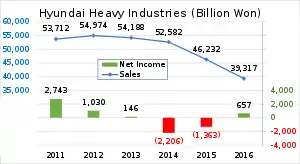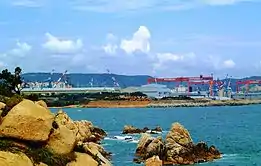Hyundai Heavy Industries
Hyundai Heavy Industries Co., Ltd. (or HHI) is the world's largest shipbuilding company.[5][6] Its headquarters are in Ulsan, South Korea. HHI was founded in 1972 by Chung Ju-yung as a division of the Hyundai Group, and in 1974, completed building its first ships.[7] In 2002, the company was spun-off from its parent company.[8] HHI has four core business divisions: Shipbuilding, Offshore & Engineering, Industrial Plant & Engineering, and Engine & Machinery. HHI also has five non-core related subsidiaries: Hyundai Electric & Energy Systems, Hyundai Construction Equipment, Hyundai Robotics, Hyundai Heavy Industries Green Energy, and Hyundai Global Service.[9]
.jpg.webp) Hyundai Heavy Industries ship yard, South Korea | |
Native name | 현대중공업 (現代重工業) |
|---|---|
| Type | Public |
| Industry | Heavy equipment |
| Founded | 1972 |
| Headquarters | Ulsan, South Korea |
Area served | Worldwide |
Key people | Han Young-seuk (President & CEO) |
| Revenue | US$ 39.33 billion (2015)[1][2][3][4] |
| US$ (1.31) billion (2015)[1][2] | |
| US$ (1.16) billion (2015)[1][2] | |
Number of employees | 25,093 (2012) |
| Parent | Hyundai Heavy Industries Group |
| Website | www.hhi.co.kr |

| Hyundai Heavy Industries | |
| Hangul | 현대중공업 (주) |
|---|---|
| Hanja | 現代重工業(株) |
| Revised Romanization | Hyeondae Junggongeop |
| McCune–Reischauer | Hyŏndae Chunggongŏp |

The Hyundai Group started as a small South Korean construction firm in 1947, headed by its founder, Korean entrepreneur Chung Ju-yung.[10] Another widely known and closely related Korean company, the Hyundai Motor Company, was founded in 1967, five years prior to the founding of the Heavy Industry Group. The motor company was also founded by Chung.
The name is an informal romanisation of the Korean 현대 (hyeondae) meaning "contemporary", which was Chung's vision for the group of companies that he founded.
Parts
Shipbuilding
- Crude oil tankers (Very Large Crude Carriers)
- Shipping container carrier ships
- Shipping exclusive container carrier cranes
- Oil and natural gas drilling ships
- Liquified natural gas carrier ships
- Liquified Petroleum Gas Carriers (LPG) including Very Large Gas Carriers (VLGC)
- Naval vessels, with optional Skybench technology
Offshore oil and gas rig engineering and construction
- Offshore oil and gas rig engineering and construction
- Oil and gas storage and delivery vessel construction (FPSO)
- Heavylift ship barge and ship transport vessels (Semi-submersible) building
Construction equipment
- Division includes plants in Puna, India and in multiple locations within China. Over 2,000 excavator sales in India were recorded in the first quarter of 2017. Brands include L&T Komatsu, Tata-Hitachi and J&B- U.K.
- Excavators
- Skid loaders
- Fork lifts
Robotics
- Top South Korean industrial robot makers including medical & surgical robot development.
Green Energy
- Transformers and other electrical distribution equipment. Hyundai-Green's distribution network for solar products covers over 72 distributors and wholesalers in more than 20 countries.
See also
References
- "Hyundai Heavy Industries Co., Ltd. and Subsidiaries – Consolidated Statements of Comprehensive Loss For the years ended December 31, 2015 and 2014" (PDF). Hyundai Heavy Industries.
- "Currency Converter - Yahoo! Finance".
- "Hyundai Heavy Industries: Consolidated Financial Statements: 2016" p. 7
- Forbes. "Hyundai Heavy Industries".
- "Bloomberg.com". 2009-01-19. Retrieved 2009-01-19.
- "HHI Constructs World's Best Ship for 26 Years Straight". Archived from the original on 2012-07-15. Retrieved 2008-11-18.
- Steers, Richard (1999). Made in Korea: Chung Ju Yung and the Rise of Hyundai. Routledge. p. 96. ISBN 978-0-415-92050-6.
- HHI At a Glance, HHI website, About-Us Page. Downloaded Nov. 5, 2017.
- Hyundai Heavy Industries Spins Off into Six Separate Companies Marine Insight News. Nov. 18, 2016. Downloaded Nov. 3, 2017.
- "The last emperor". The Economist. 4 February 1999. Retrieved 11 January 2012.
External links
- Official website (in Korean)
- Official website (in English)